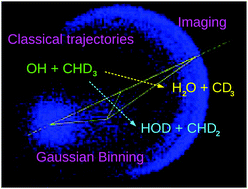Simulation of the experimental imaging results for the OH + CHD3 reaction with a simple and accurate theoretical approach†
Abstract
The OH + CHD3 reaction is among the largest one ever studied at the high-resolution level permitted by imaging techniques [B. Zhang et al., J. Phys. Chem. A, 2005, 109, 8989]. This process involves eighteen configuration space coordinates, which are large enough to make exact quantum scattering calculations beyond reach. Moreover, freezing some degrees-of-freedom in order to render these calculations feasible may lead to unrealistic predictions. However, we have found it possible to reproduce for the first time the pair-correlated measurements of Zhang et al. at a nearly quantitative level by means of full-dimensional classical trajectory calculations in a quantum spirit on a recent ab initio potential energy surface. These calculations combine the classical description of the dynamics, well suited to polyatomic systems, with Bohr quantization of both reagent and product vibrational motions. While this pseudo-quantization is exactly imposed to the reagents, it is approximately imposed to the products in a first step through energy-based Gaussian binning (1GB). In a second step, we show that the original action-based Gaussian binning (GB), long thought to be inapplicable in practice to polyatomic reactions, yields in fact results comparable in accuracy and numerical cost to those obtained by means of 1GB, provided that Gaussian weights are properly widened. This new finding clearly extends the scope of GB in theoretical reactive scattering.

- This article is part of the themed collection: 2017 PCCP HOT Articles


 Please wait while we load your content...
Please wait while we load your content...